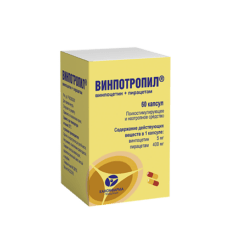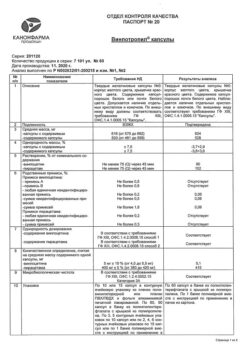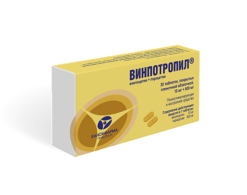No products in the cart.
Vinpotropil, 10 mg+800 mg 60 pcs
€13.96 €12.10
Description
Pharmacodynamics
Vinpotropil is a combined drug. It has properties typical for a brain blood flow enhancer (Vinpocetine) and for a nootropic (Piracetam).
As a medication that improves cerebral blood flow
It improves brain metabolism by increasing glucose and oxygen uptake by brain tissue. Increases resistance of neurons to hypoxia, enhances the transport of glucose to the brain through the blood-brain barrier, and shifts the process of glucose breakdown to a more energy-saving aerobic route; selectively blocks Ca2+-dependent phosphodiesterase; increases levels of adenosine monophosphate (AMP), cyclic guanosine monophosphate (cGMP) and adenosine triphosphate (ATP) of the brain. Increases the metabolism of brain noradrenaline and serotonin; has an antioxidant effect.
Decreases platelet aggregation and increased blood viscosity; increases red blood cell elasticity and blocks red blood cell utilization of adenosine; promotes red blood cell oxygenation. Increases cerebral blood flow; reduces cerebral vascular resistance without significant changes in systemic blood flow. Does not have the effect of “stealing” and increases blood supply, especially in ischemic areas of the brain. It penetrates through the placental barrier.
As a nootropic agent
It improves integrative activity of the brain, promotes memory consolidation, facilitates the learning process; it changes the speed of excitation distribution in the brain, improves microcirculation without having a vasodilatory effect, suppresses aggregation of activated platelets; has a protective effect in brain damage caused by hypoxia, intoxication, electric shock; it enhances α- and β-activity, reduces δ-activity in electroencephalogram, reduces the severity of vestibular nystagmus; improves communication between cerebral hemispheres and synaptic conduction in neocortical structures, increases mental activity, increases cerebral blood flow; it has no sedative, psychostimulant effect. The effect develops gradually.
It has a pronounced effect on the symptoms of initial manifestations of cognitive disorders of cerebral-vascular genesis in elderly and senile patients. It is recommended in psychogeriatric practice.
Pharmacokinetics
Vinpocetine is rapidly absorbed. Therapeutic plasma concentration is 10-20 ng/ml. Time to reach maximum plasma concentration is 1 hour. Absorption occurs mainly in the proximal parts of the gastrointestinal tract. During passage through the intestinal wall it is not metabolized.
The maximum concentration in tissues is observed 2-4 hours after oral administration. Protein binding is 66 %, bioavailability when administered orally is 7 %. Clearance 66.7 l/h exceeds liver plasma volume (50 l/h), which indicates extrahepatic metabolism. The main metabolite is apovincamic acid, which has some pharmacological activity. Other inactive metabolites are hydroxyvinpocetine, hydroxy-apovincamic acid, and hydroxyvinpocetine-glycinate. The kinetics is linear in repeated administration. The half-life (T1/2) in humans is 4.83±1.29 h. It is excreted by the kidneys and through the intestine at a ratio of 3:2.
Piracetam after oral administration is well absorbed and penetrates into various organs and tissues. Bioavailability is about 100%. After a single oral dose of 3.2 g the maximum concentration is 84 mcg/ml, after repeated (3.2 g 3 times a day) – 115 mcg/ml. Time of reaching maximum concentration in plasma – 1 hour, cerebrospinal fluid – 5 hours.
The volume of distribution is about 0.6 l/kg. It penetrates through the blood-brain barrier and placental barrier, is selectively accumulated in the cerebral cortex tissues. It is practically not biotransformed and is excreted unchanged by the kidneys through glomerular filtration. Total clearance is 80-90 ml/min. T1/2 from blood plasma is 4-5 hours, from cerebrospinal fluid – 8.5 hours.
Indications
Indications
Cerebrovascular insufficiency (recovery period of ischemic and hemorrhagic stroke);
chronic cerebral circulatory failure of hypertensive and post-traumatic origin, parkinsonism of vascular origin, intoxication;
psychoorganic syndrome with a predominance of signs of asthenia and adynamia;
symptomatic treatment of dizziness;
prevention of migraine and kinetosis.
Pharmacological effect
Pharmacological effect
Pharmacodynamics
Vinpotropil is a combination drug. It has properties characteristic of a drug that improves cerebral blood flow (vinpocetine) and a nootropic drug (piracetam).
As a means to improve cerebral blood flow
Improves brain metabolism by increasing the consumption of glucose and oxygen by brain tissue. Increases the resistance of neurons to hypoxia, enhances the transport of glucose to the brain through the blood-brain barrier; transfers the process of glucose breakdown to an energy-efficient, aerobic path; selectively blocks Ca2+-dependent phosphodiesterase; increases levels of adenosine monophosphate (AMP), cyclic guanosine monophosphate (cGMP) and adenosine triphosphate (ATP) in the brain. Strengthens the exchange of norepinephrine and serotonin in the brain; has an antioxidant effect.
Reduces platelet aggregation and increased blood viscosity; increases the elasticity of red blood cells and blocks the utilization of adenosine by red blood cells; helps to increase the release of oxygen by red blood cells. Increases cerebral blood flow; reduces cerebral vascular resistance without significantly changing systemic circulation parameters. It does not have a “stealing” effect and increases blood supply, primarily in ischemic areas of the brain. Penetrates through the placental barrier.
As a nootropic
Improves the integrative activity of the brain, promotes memory consolidation, facilitates the learning process; changes the speed of propagation of excitation in the brain, improves microcirculation without having a vasodilating effect, suppresses the aggregation of activated platelets; has a protective effect against brain damage caused by hypoxia, intoxication, and electric shock; enhances α- and β-activity, reduces δ-activity on the electroencephalogram, reduces the severity of vestibular nystagmus; improves connections between the cerebral hemispheres and synaptic conduction in neocortical structures, increases mental activity, increases cerebral blood flow; does not have a sedative or psychostimulating effect. The effect develops gradually.
It has a pronounced effect on the symptoms of the initial manifestations of cognitive impairment of cerebrovascular origin in elderly and senile patients. Recommended in psychogeriatric practice.
Pharmacokinetics
Vinpocetine is rapidly absorbed. Therapeutic concentration in plasma is 10-20 ng/ml. The time to reach maximum concentration in blood plasma is 1 hour. Absorption occurs mainly in the proximal parts of the gastrointestinal tract. When passing through the intestinal wall it is not metabolized.
The maximum concentration in tissues is observed 2-4 hours after oral administration. Protein binding – 66%, bioavailability when taken orally – 7%. Clearance of 66.7 l/h exceeds the plasma volume of the liver (50 l/h), indicating extrahepatic metabolism. The main metabolite is apovincamic acid, which has some pharmacological activity. Other inactive metabolites are hydroxy-vinpocetine, hydroxy-apovinamic acid, hydroxy-vinpocetine-glycinate. With repeated doses, the kinetics are linear. The half-life (T1/2) in humans is 4.83±1.29 hours. It is excreted by the kidneys and through the intestines in a ratio of 3:2.
After oral administration, Piracetam is well absorbed and penetrates into various organs and tissues. Bioavailability is about 100%. After a single oral dose of 3.2 g, the maximum concentration is 84 mcg/ml, after repeated oral administration (3.2 g 3 times a day) – 115 mcg/ml. Time to reach maximum concentration in plasma is 1 hour, in cerebrospinal fluid – 5 hours.
Volume of distribution is about 0.6 l/kg. Penetrates through the blood-brain and placental barriers and selectively accumulates in the tissues of the cerebral cortex. It practically does not undergo biotransformation and is excreted unchanged by the kidneys through glomerular filtration. Total clearance 80-90 ml/min. T1/2 from blood plasma – 4-5 hours, from cerebrospinal fluid – 8.5 hours.
Special instructions
Special instructions
The presence of long QT syndrome and the use of drugs that prolong the QT interval require periodic ECG monitoring.
Due to the effect of piracetam on platelet aggregation, caution is recommended when prescribing the drug to patients with impaired hemostasis, during major surgical operations, or to patients with symptoms of severe bleeding.
Impact on the ability to drive vehicles and operate machinery
During the treatment period, care should be taken when driving vehicles and operating machinery.
Active ingredient
Active ingredient
Vinpocetine, Piracetam
Composition
Composition
1 film-coated tablet contains:
active ingredients:
vinpocetine 10 mg,
piracetam 800 mg;
excipients:
calcium hydrogen phosphate dihydrate 120 mg,
croscarmellose sodium (primellose) 33 mg,
magnesium stearate 7 mg,
povidone 21 mg,
talc 7 mg,
microcrystalline cellulose 102 mg;
film shell composition:
Opadry II brown 35 mg, including: hypromellose (hydroxypropyl methylcellulose) 9.8 mg, macrogol (polyethylene glycol) 3.5 mg, lactose monohydrate (milk sugar) 12.6 mg, iron oxide red 3.08 mg, iron oxide black 5.985 mg, titanium dioxide 0.035 mg.
Pregnancy
Pregnancy
The drug is contraindicated during pregnancy and lactation.
Contraindications
Contraindications
Hypersensitivity to the components of the drug,
pregnancy,
lactation period,
severe heart rhythm disturbances,
coronary heart disease (severe),
hemorrhagic stroke,
severe chronic renal failure (creatinine clearance (CC) less than 20 ml/min),
liver failure,
The patient’s age is under 18 years.
With caution:
Impaired hemostasis, extensive surgical interventions, severe bleeding, chronic renal failure (creatinine clearance 20-80 ml/min).
Side Effects
Side Effects
From the cardiovascular system: changes in the ECG (depression of the ST segment, prolongation of the Q-T interval), tachycardia, extrasystole, lability of blood pressure (BP) (usually a decrease).
From the central nervous system (CNS): motor disinhibition, irritability, depression, asthenia, dizziness, headache, sleep disturbance (insomnia, increased drowsiness), mental agitation, imbalance, exacerbation of epilepsy, anxiety, hallucinations, confusion, extrapyramidal disorders, decreased ability to concentrate.
From the digestive system: nausea, vomiting, heartburn, diarrhea, abdominal pain, loss of appetite, gastralgia, constipation.
Metabolism: increased body weight, increased sweating.
From the senses: vertigo.
From the skin: dermatitis, itching, urticaria, skin hyperemia.
Allergic reactions: hypersensitivity, anaphylactic reactions, angioedema.
Local reactions: pain at the injection site, thrombophlebitis.
Other: fever, general weakness (may be a manifestation of an underlying disease), increased sexual activity.
Interaction
Interaction
Increases: the risk of hemorrhagic complications during heparin therapy, the effects of thyroid hormones, antipsychotics (neuroleptics), psychostimulants, indirect anticoagulants, including acenocoumarol (a more pronounced decrease in platelet aggregation, fibrinogen content, von Willebrand factor, plasma and blood viscosity).
A slight increase in the hypotensive effect is possible when used simultaneously with methyldopa (blood pressure control is necessary).
Weakens: the effect of anticonvulsants (lowers the seizure threshold).
Despite the lack of data confirming the possibility of interaction, caution is recommended when coadministered with centrally acting antiarrhythmic drugs.
Overdose
Overdose
Symptoms: abdominal pain, bloody diarrhea.
Treatment: symptomatic therapy, hemodialysis (effectiveness 50-60%).
Storage conditions
Storage conditions
In a dry place, protected from light, at a temperature not exceeding 25 ° C.
Shelf life
Shelf life
2 years.
Manufacturer
Manufacturer
Kanonpharma production CJSC, Russia
Additional information
| Shelf life | 2 years. |
|---|---|
| Conditions of storage | In a dry, light-protected place at a temperature not exceeding 25 ° C. |
| Manufacturer | Kanonfarma Production ZAO, Russia |
| Medication form | pills |
| Brand | Kanonfarma Production ZAO |
Other forms…
Related products
Buy Vinpotropil, 10 mg+800 mg 60 pcs with delivery to USA, UK, Europe and over 120 other countries.

















